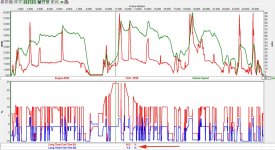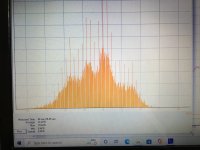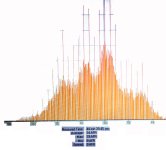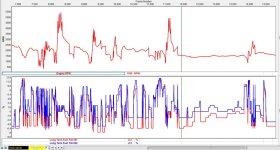I have a sensor in each of the duel pipes. Very similar AFRs with any higher value swapping between sides. A sustained variation might indicate a problem on one bank of the engine or the need to recalibrate or replace a sensor. Carburation problems should not effect one bank more than the other as each side of the carburettor feeds two cylinders on each bank.
Carb would not cause an imbalance, but is used as to jetting to adjust for actions of Ethanol
But others things can
Here is an example of a 2010 C6 Z06
Owner put some stupid so-called performance mods on it and car ran like crap, so he came to me to debug and then tune PCM up
In analyzing the OBD recorded data, I found this crap
Notice at times B1 was 25% too lean while B2 was -1.6% rich, what a cluster frick that was
This would not happen when people owning a sports car are not monitoring how engine or tranny is functioning
The cause of this and almost screwed his 427 CI engine was, he got sucked into a high dollar mod that is of course to give 200 HP gains
by replacing the stock intake manifold
This type4 was really designed for one purpose, only and that is when using N20 (NOS) if there was a F up that instead of the engine blowing to hell
this intake design is 2 sections and when the big bang happens with NOS that instead the intake comes apart
Well crappy design and what happened due to heat was the intake on the left side had warped at the left rear corner, so there was unmetered air being sucked into that side :-(
25% lean in hot summer weather is asking for a ass banging for sure

Not the carb in your case, but still ill effects from
1. leaking exhaust manifold on one side, pulling in air to cylinder(s)
2. shape of intake manifold causing imbalance
3. If having headers, length of each primary, if lousy design not all same exhaust flow length
4. back pressure, one side flows better than other side
5. cylinders not getting clearing out exhaust fully and not cycle dirty charge in cylinder
6. one side exhaust pulses to help extract exhaust by some issue with exhaust downstream
7. if using WB sensors, one not correct or getting air leak close to it.
If fuel injected and engine controller, other things can fact into why one side's AFR is different





